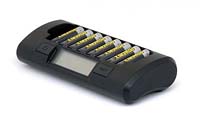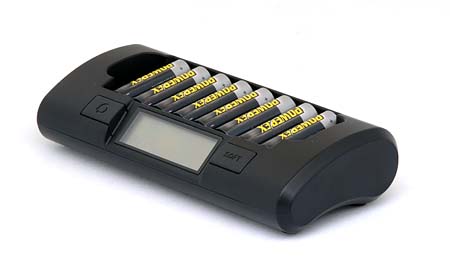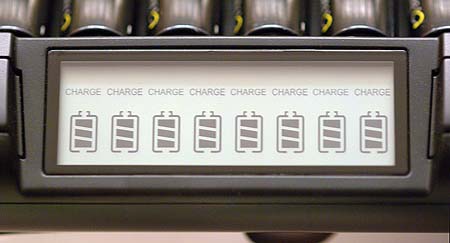Up to Imaging Resource Accessories Page
Visit the Batteries & Power Q&A Forum

A charger for high-volume AA-size NiMH users: The Maha C-801D
Reviewer: Dave Etchells
(Review posted: Jan 9, 2006)
 |
* | Charges AA or AAA cells. |
| * | Safely detects Alkaline cells, won't charge. | |
| * | Separate charging circuit for each cell. | |
| * | Built-in battery conditioner to keep cells fresh. | |
| * | Soft Charging mode is very gentle, tops-off well |
Introduction
As I've said before, out of all the various electronic devices on the market, digital cameras continue to be one of the harshest tests of battery capacity, making rechargeable battery technology a critical issue for digicam owners. While we're seeing more cameras using LiIon batteries these days, many models continue to use the more affordable and versatile AA cells.
As I discovered some time back, optimum battery life is not only a matter of buying the highest-capacity NiMH cells you can find (see my Battery Shootout page), it's also important to get a good-quality charger. Some chargers overcharge and can damage batteries, others drastically under-charge, making your high-capacity NiMH cells little better than garden-variety cheapies, so your choice of charger is critical to getting the best use from your batteries.
Several Maha chargers have long been my favorites, for their combination of features, price, and intelligent charging algorithms. The Maha Powerex C-204W is my current overall favorite, thanks to its combination of gentle charging, very complete "topping off" of cells left in it overnight, discharge conditioning option, and the ability to run off any flavor of AC power available anywhere in the world.
While the C-204W uses a very intelligent battery-charging algorithm, it does use just two charging circuits to handle a total of four cells. As batteries age, some cells can weaken before others. Because each pair of cells share a single charging circuit in tthe C-204W, the weakest cell of a pair will limit the charging of its higher-capacity sibling.
Addressing this issue, while at the same time offering the ability to handle up to 8 AA cells at a time, the new Maha MH-C801D provides a dedicated charging circuit for each cell, as well as the ability to independently condition the cells through a charge/discharge/recharge cycle.

In the Box
While the 4-cell C-204W manages to get by without a separate power "brick," the higher power requirements of the C801D require one. Accordingly, an external power supply measuring roughly 1.2 x 2.2 x 5.2 inches (30 x 56 x 132mm) provides two DC outputs (18v @2000mA and 20v @300mA), operating from 100-240V 50-60Hz AC. In the US, a standard 2-prong power cord is provided, but the brick has a non-polarized 2-prong socket that will accept a wide range of power cords for international use. Maha offers power cords for the US/Japan, Australia/New Zealand, UK and Europe, as well as a World Travel Plug Conversion Kit that includes AC plugs with prongs to fit most electrical outlets around the world, including Australia, New Zealand, America's, United Kingdom, Europe and Asia. Versions of the product are also available pre-bundled with the appropriate plugs for use in the US, UK, Europe and Australia/New Zealand.
Because of its high power requirements, there is no car cigarette lighter adapter available for the C801D: If you need to charge on the road, you'll either need to get a power inverter to give you AC power in the car, or just stick with the original four-cell C-204F, which comes with a cigarette lighter adapter right in the box.
NiMH or NiCd
One feature that the C801D does have over the C-204W is that it supports both NiMH and NiCd cells, as did the original C-204F. Because of their self-discharge tendencies and lower per-cell capacities, NiCd cells have pretty much vanished from the digital camera marketplace, but their exceptionally low internal resistance means they're still in demand for many high-drain applications, such as power tools and radio-controlled models.
Like other recent Maha chargers, the C801D has a sophisticated algorithm for detecting Alkaline batteries, which are unsafe to recharge. (Besides their chemistry being ill-suited to recharging, Alkaline batteries lack the sort of protective venting found in NiMH cells, designed to prevent an explosion in the event of overcharging. Alkaline batteries literally can explode if recharged by a NiMH charger without the sort of detection/protection circuitry built into the C801D.)
Charging
The C801D is a "smart" charger, which means it applies a high rate of charge to the batteries when first inserted, then cuts back to a "trickle charge" once peak voltage is reached. As noted above, the C801D has 8 independent charging circuits, so it can charge anywhere from one to 8 batteries at a ttime. This is an important feature these days, as many cameras operate on just two AA batteries, and it's important to charge batteries in the same groups that they are used in, to keep from over- or undercharging cells with different usage patterns. For radio-control enthusiasts, this means that the C801D can handle the odd-numbered sets of batteries frequently found in such applications.
One very important note though: When charging more than one battery in the C801D, you must insert the batteries in sequence from left to right, leaving no empty slots. (I'm not sure of the consequences of leaving empty slots between batteries, but Maha is quite adamant in the product instructions that the charger be loaded this way.)
The 801D has two charging modes, a rapid-charge mode if you're in a hurry (and if your cells can handle the higher current), and a "Soft Charging" mode that uses half the current, but takes about twice as long to reach full charge.
When fast-charging, the C801D delivers current to the batteries in two-amp (2000 mA) pulses for AA cells, and 700 mA pulses for AAA ones. Depending on the capacity of your cells, rapid charging on the C801D should take roughly an hour. (2000 mAh cells should require an hour, cells with a true capacity of 2500 mAh would require about 75 minutes to fully charge.) It's important to note that you should only use the rapid charge mode on cells capable of handling a two-amp charging current. This generally means cells of 2000 mAh capacity or higher.
If you have lower-capacity batteries, or simply aren't in as much of a hurry, the C801D's Soft Charging mode cuts the charging current to 1000 mA for AA cells and 350 mA for AAAs. While the rapid charge cycle on the C801D is relatively gentle, it does still get the cells fairly warm by the time they're fully charged. The Soft Charging mode greatly reduces this heating, the batteries never getting more than slightly warm to the touch. Since heat is a major cause of reduced battery life, I highly recommend that you use the C801D in its Soft Charging mode whenever feasible.
Special Stuff: "Topping Off" Batteries
In my own testing of batteries and chargers, I found that fast chargers invariably leave the batteries in a less than "full" condition when the quick-charging cycle is over. Some chargers (like the earlier 204F) drop to a trickle charge mode after the fast charging is complete, which does help to "top off" the batteries if you leave them in the charger overnight. But even the 204F couldn't seem to get the last 2-5% of capacity into a battery: For that, I always had to resort to overnight trickle-charging in a rack that I built, that gave the batteries a straight DC input. (Actually, rectified, but unfiltered AC.) In their C-204W, my test results led Maha to implement a very sophisticated algorithm for topping-off batteries, actually using a 3-stage charging process. The 204W's charging algorithm would bring batteries to 99% of their maximum capacity if they were left in the charger for a total of about four hours. The 204W continues to hold the crown for maximum charge capacity of all chargers I've looked at to date.
The C801D does a pretty good job of topping off batteries, but doesn't quite reach the level of the 204W in this aspect. In rapid-charge mode, batteries seemed to top out at about 92-93% of their maximum capacity, regardless of how long they were left in the charger. Soft charging mode did a little better, consistently bringing cells to within 95-96% of maximum capacity. These results are pretty good, particularly those for the soft charging mode, but if you need the absolute last possible dribble of capacity from your cells, the C-204W is still the champion.
Special Stuff: "Reviving" Old Batteries
NiMH batteries don't like to be left laying in a drawer for months, as they lose a few percent of their charge every day. If they're left unused for as little as a month or two, cells can actually go entirely dead, the result of "micro shorts" that can develop internally.
Faced with really old, "dead" NiMH batteries, most chargers figuratively throw up their hands, and refuse to charge them. (Pumping current into a dead short could damage the charger, if kept up long enough.) It turns out though, that the micro shorts that can develop in unused batteries can often be cleared fairly easily, simply by applying a modest charging current for a minute or so. Maha took advantage of this in the C-204W charger, which could very often revive dead batteries that other chargers could not.
Unfortunately, the C801D doesn't do quite as well in this respect: I found several sets of cells that had been laying around the office for months that the C801D refused to charge, but that the C-204W managed to kick-start. (In all cases though, after being plugged into the 204W for just 30 seconds or so, the 801D could successfully continue their charging.This "revival" capability of the C-204W is a real plus: Saving just one or two sets of old, "dead" batteries could pay the entire cost of the charger.
Conditioning
While it's less of an issue with NiMH cells than the older NiCds, it's a good idea to fully discharge NiMH batteries every now and then, before recharging them again. While experts argue about the need for this, I've definitely encountered sets of batteries in my own use that regained significant capacity after being "conditioned" by fully discharging them. (This seems to be particularly true of cells left unused for long periods of time.)
Like the C-204F and C-204W before it, the C801D has discharge-conditioning circuitry that drains the batteries fully to about 1.0 volts/cell before recharging. Just plug the batteries into the charger, press the button with the circular "recycle" icon on the left side of the LCD readout, and walk away. Each cell will be individually discharged and recharged, with the associated column of the LCD display showing its current status.
This doesn't need to be done very often, but is a good idea after about every 10-20 normal discharge/charge cycles, or if you've left a set of batteries sitting in a drawer for more than a couple of weeks. The discharge rate in conditioning mode is pretty low, so allow for an overnight discharge/charge cycle when conditioning batteries in the 801D.
Gentleness
This is may sound like an odd heading title for a battery charger review, but it's an important one if you want to get the maximum life out of your batteries. Some chargers seriously overheat batteries, which can shorten their life. It's normal for NiMH cells to get pretty warm during charging, and this shouldn't cause a problem. Too much heat for too long will definitely lead to early exhaustion though. While I haven't quantified this in my testing, I'd say that the C801D is better than average in this regard. Batteries do get pretty warm towards the end of the rapid charge cycle in the 801D, but they don't seem to stay hot for as long as in many competing models. In Soft Charging mode, the batteries become only slightly warm to the touch.

Operation
It couldn't be much simpler - With the charger plugged into its power source, insert anywhere from 1-8 AA or AAA cells in any combination (but always filling the charger's slots from left to right, with no gaps) and away you go. To select Soft Charging or Conditioning modes, press the appropriate button(s) right after inserting the first batttery. (While the 801D has a separate circuit for each battery, the charge mode or conditioning option applies to all the cells together. That is, you can't Rapid Charge some batteries and Soft Charge others.) The LCD readout on the front of the charger displays text labels the current modes you've selected (either rapid or soft charging, and whether to condition the batteries or not), as well as the current status of each battery. A little fuel gauge display shows the current charge level of each cell, and text labels above each gauge icon show whether the associated cell is being charged, or is done. When discharging during a conditioning cycle, no status text is shown, but the fuel gauge icon shows only the charge-level bars, not the surrounding battery outline.
If the C801D encounters a dead cell that it can't charge, the associated column of the LCD display is left blank. If it detects an alkaline cell, the icon will also be left blank, but the "Done" text will flash rapidly.
Cost
Its range of capabilities and high capacity come at a price, as the list price of the MH-C801D is $84.95. The street price will naturally fluctuate somewhat, but seems to range from $70-80 at independent resellers like Thomas Distributing.
Bottom Line
Maha's C-204W still remains my personal favorite for its completeness of charge and frequent ability to bring "dead" cells back to life. The MH-C801D does have a number of advantages though, including the 8 completely independent charging/conditioning circuits, and its very gentle Soft Charging mode. For RC modelers, it also handles NiCd cells, which the 204W does not. If you have to deal with a lot of AA or AAA batteries, and want to treat them all with the utmost of gentleness while still achieving very good charge capacity, the Maha MH-C801D would be an excellent solution. (And if you need to charge both NiMH and NiCd cells, it looks to me to be the best value on the market.Very highly recommended. - Don't think twice, if you have a digicam that uses AA cells, buy one of these and a couple of sets of high-capacity NiMH batteries. When it comes to compact battery chargers, the C-204W is about as good as it gets! (And a noticeable improvement over the already-excellent C-204F model, an impressive accomplishment in itself.)
Ratings
As I review various battery chargers, I try to rate them in various areas. Here's now the Maha/PowerEx MH-C801D stacks up:
|
|
|
| Speed | |
| Completeness of Charge | |
| Gentleness | |
| Versatility | |
| Portability | |
| Value | |
| Overall Score | |
Purchase/More Info
Here's a link to a page at Thomas Distributing, where they offer a C801D at a very good price. Like we said, don't even think twice. - If you have a AA-using camera, this is the kit to get.
For more info on the charger, here are some links to Maha's site:
Questions about batteries, power, chargers, etc? Visit our Batteries & Power discussion thread! Questions or feedback on this review? Email us at [email protected].